Uttar Pradesh (U.P.)
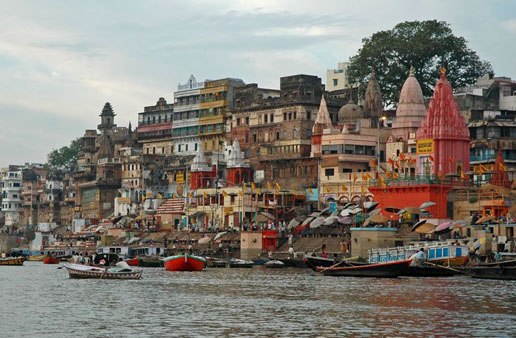
(Uttar Pradesh, Varanasi Ghat)
Culture of Uttar Pradesh or UP
Religions of Uttar Pradesh
Uttar Pradesh is a state of Hinduism, more 80% of total population follows Hindu religion and other religions of the state are Muslim (18% of the population), Sikhs, Buddhists, Christians and Jains. Some tribal communities like Tharus, Boksas, Bhotia, Jaunswaris and Rajis, Agaria, Baiga, Bhar, Bhoksa, Bind, Chero, Gond, Kol and Korwa are also found in UP. Among the above mention tribal first five communities have been recognized as scheduled tribes.
Festivals in Uttar Pradesh
The state people celebrate lots of colorful and amazing festivals. Some most popular of these are The Taj Mahotsav (in the February), Jhansi Festival (during February-March), Festival of color (Holi), Buddha Mahotsav, Vrindavan Sharadotsav, Ganga Festival and the Lucknow Festival (during winter).
Languages in Uttar Pradesh
People of UP usually use Hindi and Urdu dialect as their main spoken language but officially Hindi is accepted. Some other small linguistic community group reside here, they are Bagheli, Budeli, Punjabi and Hariyanvi.
Religions of Uttar Pradesh
Uttar Pradesh is a state of Hinduism, more 80% of total population follows Hindu religion and other religions of the state are Muslim (18% of the population), Sikhs, Buddhists, Christians and Jains. Some tribal communities like Tharus, Boksas, Bhotia, Jaunswaris and Rajis, Agaria, Baiga, Bhar, Bhoksa, Bind, Chero, Gond, Kol and Korwa are also found in UP. Among the above mention tribal first five communities have been recognized as scheduled tribes.
Festivals in Uttar Pradesh
The state people celebrate lots of colorful and amazing festivals. Some most popular of these are The Taj Mahotsav (in the February), Jhansi Festival (during February-March), Festival of color (Holi), Buddha Mahotsav, Vrindavan Sharadotsav, Ganga Festival and the Lucknow Festival (during winter).
Languages in Uttar Pradesh
People of UP usually use Hindi and Urdu dialect as their main spoken language but officially Hindi is accepted. Some other small linguistic community group reside here, they are Bagheli, Budeli, Punjabi and Hariyanvi.
Climate of Uttar Pradesh
The climate of Uttar Pradesh usually is subtropical, but it changes noticeably with its land height. The climate of eastern zone of UP is Temperate but the western zone is Extreme and you found Semi Arid climate type in Bundelkhand and Agra.
Weather in summer
Normally the summer season of UP is continued from end of March to August and the temperatures varies from 45°C (in daytime) to 28°C (at night). Dew is very common throughout the state in summer.
Weather in winter
Normally the Winters season of UP is continued from Mid-November to End of February and the temperatures varies from 24°C (in daytime) to 3°C (at night). Cities like Allahabad and Varanasi of Northern parts of the Himalayan region of UP is usually covered with average 3 meters to 5 meters snowfall in winter.
Weather in monsoon
Normally the monsoon season of UP is continued from June to September and more than 90% of the annual rainfall occurs during this season due to the southwest Monsoon. The average annual rainfall of up varies from 105 cm to 110 cm in Allahabad, Varanasi and Azamgarh but some places like Agra, Ghaziabad and Merrut it is very low 45cm to 50cm.
The climate of Uttar Pradesh usually is subtropical, but it changes noticeably with its land height. The climate of eastern zone of UP is Temperate but the western zone is Extreme and you found Semi Arid climate type in Bundelkhand and Agra.
Weather in summer
Normally the summer season of UP is continued from end of March to August and the temperatures varies from 45°C (in daytime) to 28°C (at night). Dew is very common throughout the state in summer.
Weather in winter
Normally the Winters season of UP is continued from Mid-November to End of February and the temperatures varies from 24°C (in daytime) to 3°C (at night). Cities like Allahabad and Varanasi of Northern parts of the Himalayan region of UP is usually covered with average 3 meters to 5 meters snowfall in winter.
Weather in monsoon
Normally the monsoon season of UP is continued from June to September and more than 90% of the annual rainfall occurs during this season due to the southwest Monsoon. The average annual rainfall of up varies from 105 cm to 110 cm in Allahabad, Varanasi and Azamgarh but some places like Agra, Ghaziabad and Merrut it is very low 45cm to 50cm.
Arunachal Pradesh
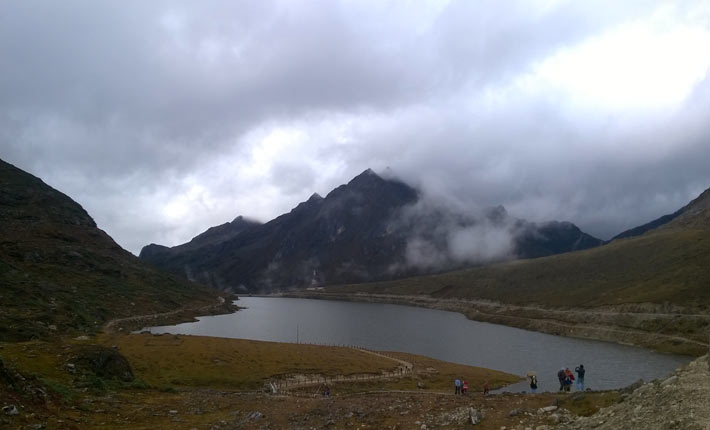
(Sela Lake at Sela Pass, Arunachal Pradesh)
Arunachal Pradesh, east most Himalayan State lying between 26°30'N and 29°30'N latitude and between 91°30'E and 97°30'E longitude is the state of sunrise in India. It panoramic natural beauty and fresh air are most valuable property in our polluted and artificial World. Read more...
Culture of Arunachal Pradesh
| Quick Facts | |
|---|---|
| Established | 20th February, 1987 |
| Area | 83,743 km2 |
| Capital | Itanagar |
| Towns | Along, Anini, Bomdila, Daporijo, Khonsa, Pashighat, Seppa, Tawang, Teju, Walong, Yingkiong and Ziro |
| Districts | 20 |
| Population (2011) | 1,382,611 Male - 720,232 Female - 662,379 Density - 17/km2 |
| Religion | Christian (30.26%), Hindu (29.04%), Others (mostly Donyi-Polo) (26.2%), Buddhist (11.76%), Muslim (1.9%) and Sikh (0.1%) |
| Temperature | Summer: 13°C to 21°C Winter: 0°C to 12°C |
| Rainfall | 300 cm to 500 cm |
| Languages | English (Official Language), Nyishi, Adi, Bengali, Nepali, Hindi, Monpa, |
Languages in Arunachal Pradesh: The tribes of Arunachal Pradesh are divided into 82 different tribal groups which make approximately 65% of total state population. Major tribes of the state are Adi, Nishi, Monpa, Galo and Apatani. Every tribal groups practice their own traditional culture. They speak with their own regional or tribal dialect. There have more over 50 tribal dialects some major of them are Dafla, Adi Gallong, Mishri, Monpa, Aka, Khamti, Nishi, Wancho and Tagin.
Non-tribal people of the state mainly use Hindi as their first language. Assamese, Bengali, Nepali and English are also spoken by some people. Among them Hindi and English are the main medium for official uses and education system.
Festivals in Arunachal Pradesh: State tribes of Arunachal Pradesh celebrate lots of religious, seasonal and socio-cultural festivals throughout the year. Sacrifice of Animal in festivals is a common ritual in Arunachal Pradesh. Some major festivals of the state are Lossar, Gomkum gompa, Dree, Si-Donyi, Boori Boot, Solung, Aran, Mopin, Tamladu, Sangken, Reh, Oriah, Mol and Nyokum.
Religions in Arunachal Pradesh: Most of the tribes of Arunachal Pradesh mainly follow Donyi Polo religions. Hinduism also a major accepted religions in the state after the animist traditions are merged with Hindu. People of Tawang and West Kameng are mostly follows the Tibetan Buddhism. As of the 2011 census, major religions of the state are Christian (30.26%), Hindu (29.04%), Others (mostly Donyi-Polo) (26.2%), Buddhist (11.76%), Muslim (1.9%) and Sikh (0.1%).
Climate of Arunachal Pradesh
The climate of Arunachal Pradesh is basically depends on its elevations. The state can be divided into three climatic zones. North most part of Arunachal Pradesh close to China-Tibet border is the high elevated area. It is the part of Upper-Himalayas and this region fall under the alpine or Tundra climatic zone with a temperature bellow the freezing point in winter. The region located in the middle Himalaya is called as temperate climate zone. And the climate of lower elevation or foothills of Himalaya is quite hot than other two climatic zone.
Summer season: Usually this season is continued from April to June and temperature varies from 10° C to 22° C during this season. Hilly region of the state is comfortable during this season.
Winter season: Usually this season is continued from end-October to February and temperature varies from 0° C to 12° C during this season. Some regions of higher climatic zone of the state get a temperature bellow freezing point during this season.
Monsoon in Arunachal: Usually this season is continued from July to September. Annual average rainfall of the state varies from 300cm to 500cm.
Tripura
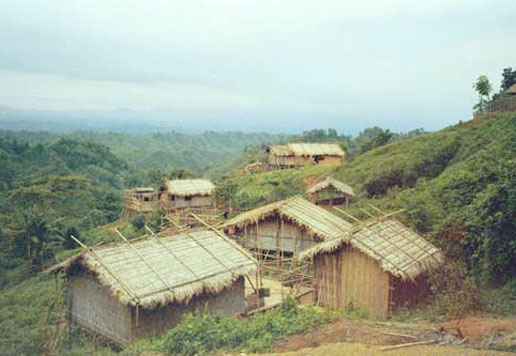
(A village on Hill in Tripura)
The capital city of Tripura is Agartala and it is also the largest city in the state and the second largest city in the North-East India, after Guwahati, Assam. Other big cities of the state are Bishalgarh, Sonamura, Amarpur, Dharmanagar, Pratapgarh, Udaipur, Kailashahar, Teliamura, Khowai, Sabroom, Belonia and Badharghat. The state is build up with eight administrative districts namely, North Tripura, Unokoti, Dhalai, Khowai, West Tripura, Shipahijala, Gomati and South Tripura. Read more...
People of Tripura
Tripura is a Bengali populated state, represents almost 67 per cent of the total population of Tripura, while rest 32 per cent belongs into Indigenous communities, the native tribal communities of Tripura, they are defined as "scheduled tribes", the most disadvantaged groups of people recognized by the constitution of India. Some Manipuri and others communities also reside in Tripura. All tribes of Tripura belongs into nineteen ethnic groups and many more sub-groups, with diverse languages and cultures. Kokborok-speaking Tripuris are the major community of them, other communities are Reang, Jamatia, Chakma, Lusai, Mog, Garo, Kuki, Chaimal, Uchai, Hala, Khasia, Bhutia, Munda, Orang, Lepcha, Santal, Bhil, and Noatia lived together with a peaceful harmony.
Languages:
Tripura is a Bengali dominated states and so most of the people in Tripura speaks in Bengali language. Kokborok is a widely speaking language among the Tripuri tribes and the second most populous language in Tripura. Some other language of Tripura, which are used to daily communications between some communities are Mog, Odia, Bishnupriya Manipuri, Manipuri, Halam, Kuki, Garo and Chakma belonging to Indo-European and Sino-Tibetan language families. Other than the states own languages, most of the people know Hindi and can speak on it, some of them are also understand and speaks English too. Bengali and Kokborok are two official languages in Tripura. English is also used for official purpose in the state.
Religion:
Tripura is a Hindu majority state. According to 2011 census, 83.4 per cent of total state population follows Hinduism. Islam is the second largest religion in Tripura, 8.6 per cent state population are followers of Muslims. Christians is the third largest religion with 4.35 per cent of total population, and Buddhists are the fourth largest religion with 3.41 per cent followers of the state Tripura. Mogs (Barua & Mutsuddy also comes under Mog community) and Chakmas are the followers of Buddhism in Tripura. Some other religions of Tripura are Sikhism (0.02%) and Jainism (0.02%).
Climate of Tripura
The climate of the state is tropical type with a pleasant weather and humidity in winter. The weather characters of Tripura mainly depend on the wind flows of Bay of Bengal and it produces a heavy rainfall during the monsoon season. The climate season of the state can be divided into three divisions namely, summer, winter and monsoon.
Weather in summer
Normally the summer season of Tripura is continued from mid of March to June. The average temperatures during this season is 34°C.
Weather in winter
Normally the winter season of Tripura is continued from November to early February and the average temperature during this season is about 11°C.
Weather in monsoon
Normally the monsoon season of Tripura is continued from July to September and the average annual rainfall of the state is approximately 210cm. Kamalpur region receives the highest Rain fall 285.5 cm in monsoon and the Sonamura region is lowest Rain fall area with average rainfalls 181.1 cm.
Culture of Tripura
Festivals in Tripura Kharchi Puja is the most popular festival in Tripura. It is a festival continues for seven days during the month of June or July close to the capital city of Agartala. Other popular festivals of the state are Garia Puja (tribal festival), Durga Puja, Dewali, Pilak Festival, Pous Sankranti Mela, Neermahal Festivals, Swimming and Boat Race (in July or August), Orange and Tourism festival and the Bizu Festival.
Bihar

(Shershah Suri Masjid in Bihar)
The state builds up with nine administrative divisions namely, Patna, Tirhut, Saran, Darbhanga, Kosi, Purnia, Bhagalpur, Munger and Magadha. And these divisions are divided into thirty-eight distinct districts. According to the landforms and geographical reasons the state is divided in four regions. These are the Angika Region, Bhojpur, Magadh and Mithila Region. Read more...
Climate of Bihar
The overall weather report in a year of the state usually are quite good and comfortable than other states. It get a pleasant and comfortable temperature (average 27°C) in the months of October, November, February and March.
Weather in summer: Normally the summer season of Bihar is continued from mid of March to Mid-June. The average temperature during this season is 34°C.
Weather in winter: Normally the winter season of Bihar is continued from End of November to Mid-February and the average temperature during this season is 10°C.
Weather in monsoon: Normally the monsoon season of Bihar is continued from Mid-July to September. Average annual rainfall of the state is approximately 120 cm.
Culture in Bihar
Major Languages in Bihar: Usually the people of the state use Hindi as their main spoken language but three other languages namely Urdu, Maithili and Magahi are also widely used. These four languages are considered as official language of the state. Beside of these, there have several local or regional tribal languages in Bihar, popularly known as Bihari language. Maximum of these languages are similar to Hindi Dialect but these are very crude, major of them are Angika, Bhojpuri, Magadhi, Maithili and Bajjika.
Major Festivals in Bihar: Chhath or Dala Chhath is the most popular festival in Bihar which celebrated twice a year, once in Chaitra Month (according to local calendar) or in summers, called as Chaiti Chhath and another in Kartik Month (according to local calendar) or in winter, called as Kartik Chhath. Some other popular festivals of the state are Shravani Mela, Teej, Chitragupta Puja, Makar Sankranti, Saraswati Puja, Holi, Eid-ul-Zuha, Muharram, Ram Navami, Rath yatra, Raksha Bandhan, Maha Shivaratri and Durga Puja.
Major Religions in Bihar: The main religion of the state is Hinduism near about 83% of total population follow this religion. Some other religion followers of the state are Muslim (16%) and rest 1% are Sikhism, Jainism, Buddhism, and Christianity.
Chhattisgarh
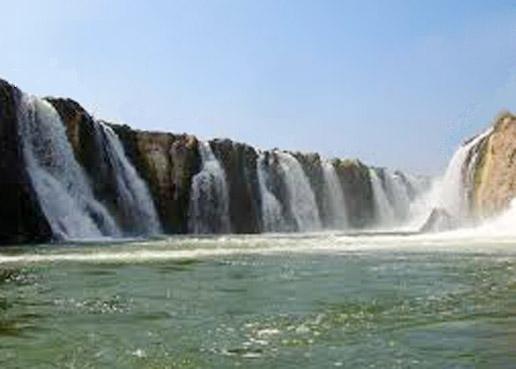
(Chitrakot Waterfall also known as "Niagara of India"
(Chitrakot Waterfall also known as "Niagara of India"
Climate of Chhattisgarh
The climate of the state is typically hot in summer but a pleasant temperature and humidity in winter. The weather characters of Chhattisgarh mainly depend on the wind flows of Bay of Bengal which produce a heavy rainfall during monsoon season.
Weather in summer: Normally the summer season of Chhattisgarh is continued from end of March to June. Average temperatures varies during this season from 28°C to 46°C.
Weather in winter: Normally the winter season of Chhattisghar is continued from November to early February and the temperatures varies during this season from 6°C to 26°C.
Weather in monsoon: Normally the monsoon season of Chhattisgarh is continued from July to October. Average annual rainfall of the state is approximately 130 cm.
The climate of the state is typically hot in summer but a pleasant temperature and humidity in winter. The weather characters of Chhattisgarh mainly depend on the wind flows of Bay of Bengal which produce a heavy rainfall during monsoon season.
Weather in summer: Normally the summer season of Chhattisgarh is continued from end of March to June. Average temperatures varies during this season from 28°C to 46°C.
Weather in winter: Normally the winter season of Chhattisghar is continued from November to early February and the temperatures varies during this season from 6°C to 26°C.
Weather in monsoon: Normally the monsoon season of Chhattisgarh is continued from July to October. Average annual rainfall of the state is approximately 130 cm.
Culture Chhattisgarh
Languages in Chhattisgarh: Usually the people of the state use Hindi as their main spoken and official language but there have some other regional or tribal languages. These languages are popularly known as Chhattisgarhi language. Maximum of these languages are similar to Hindi Dialect but these are very crude, some of these are Khaltahi, Laria, and Oriya.
Festivals in Chhattisgarh: The people of Chhattisgarh divided into several primitive tribal groups. These tribal groups practice a unique culture, folklores, festivals and dance forms. Major festivals of the state are Hareli, Madai, Bhagoriya, Dusshera, Ganga Dashera, Charta, Navakhai and Surhul Festival.
Religions in Chhattisgarh: The main religion of the state is Hinduism near about 96% of total population follow this religion. The tribal communities of the state follow Hinduism. Some other religion followers of the state are Muslim, Sikhism, Jainism, Buddhism, and Christianity.
Languages in Chhattisgarh: Usually the people of the state use Hindi as their main spoken and official language but there have some other regional or tribal languages. These languages are popularly known as Chhattisgarhi language. Maximum of these languages are similar to Hindi Dialect but these are very crude, some of these are Khaltahi, Laria, and Oriya.
Festivals in Chhattisgarh: The people of Chhattisgarh divided into several primitive tribal groups. These tribal groups practice a unique culture, folklores, festivals and dance forms. Major festivals of the state are Hareli, Madai, Bhagoriya, Dusshera, Ganga Dashera, Charta, Navakhai and Surhul Festival.
Religions in Chhattisgarh: The main religion of the state is Hinduism near about 96% of total population follow this religion. The tribal communities of the state follow Hinduism. Some other religion followers of the state are Muslim, Sikhism, Jainism, Buddhism, and Christianity.
Welcome to Goa

There have only two districts in Goa namely, North Goa District and South Goa District. These districts consist of several big cities like Panaji, Ponda, Mapusa, Margao, Mormugao, Vasco Da Gama, etc. Among these Panaji is accepted as Capital City as well as administrative headquarter of North Goa District. Other hand, the Margao City is the district headquarters of South Goa District and the city of Vasco Da Gama is largest in Goa State.
Climate of Goa
The climate of Goa usually is in tropical zone and produces a heavy rain due to wind of the Arabian Sea. Three major seasons are found in Goa, namely, summer, winter and monsoon.
Summer in Goa: Usually, this season persists for a long times (March to July) in Goa. Temperature may reach up to 45°C with a high humidity in May. Average temperature during this season varies from 30°C to 40°C.
Monsoon in Goa: Usually, monsoon is continued from mid-June to September in Goa. Due to the proximity of Arabian Sea Goa receive heavy rainfalls and some thunderstorms during this season. Average annual rainfalls of Goa are approximately 300 cm.
Winter in Goa: Usually, winter season of Goa persists for a short terms (December to mid-February) with a pleasant temperature. Average temperature during this season varies from 18°C to 28°C.
Languages and Religions in Goa
As per census report 2011 of India approximately 1,458,545 people reside in Goa. Among them about 66% of population are belongs to Hinduism, 26.5% Christians, 6.9% Muslims, and rest are Buddhist and Sikh with a low percent. Maximum of Goans survive with the profession of fishing. Now a day’s tourism is another source of income by the inhabitants of Goa.
People of the state mainly use Konkani as their main dialect. Near about 60.1% of population speak this language. Some other major spoken languages of Goa are Marathi 24.9% (approx), Kannada 11% and some small linguistic groups. Konkani is accepted as the official language of the state and English language is also used few regions.
state Gujarat

Climate of Gujarat
Climate of Gujarat usually is dry and temperate type. The state is mainly influenced by three types whether season, namely summer, winter and monsoon.
Weather in summer: Normally the summer season of Gujrat is continued from End of March to June. The average temperature during this season varies between 26° C to 46° C.
Weather in winter: Normally the winter season of Gujarat is continued from December to February and the average temperature during this season varies between 13° C to 28° C.
Weather in monsoon: Normally the monsoon season of Gujarat is continued from mid of June to mid of September and the average rainfall during this season is approximately 200 cm.
Culture of Gujarat
Festivals in Gujarat: More over thousands of fair and festivals are celebrated here in a year and so Gujarat is called as also the land of fairs and festivals. Some important seasonal fairs or Mela of the state are Bhavnath Mahadev fair (every year in February) at Junagadh city, Dangs Darbar fair (every year in March) at Ahwa, Vichitra Mela or fair (tribal fair, every year in March) at Gunbhakhari and many more. Besides of these people of the state practice several religious festivals with great enthusiasm. Some of these are Makar Sankranti, Dance Festival popularly known as Modhera (every year in January), Kutch or Rann Mahotsav (during February or March), Bhadra Purnima (usually in September) and Navratri or nine nights Festival (during September or October).
Language and Religions in Gujarat: Gujarati is the main dialect of Gujarat and a majority percentage (84.5) of resident uses this as their first language as well as official language. Other used dialects of the state are Hindi (speak 4.8% of population), Sindhi (speak 2% of population), Marathi (speak 1.5% of population), Urdhu (speak 1% of population) and 4.9% of population use some regional (especially tribal community) languages. The people of Gujarat mainly follow Hindu religion (89.1%) rest are Muslim (9.1%), Jainism (0.1%), and Sikhism (0.8%). Some tribal communities reside here with a less percentage population.
state Haryana
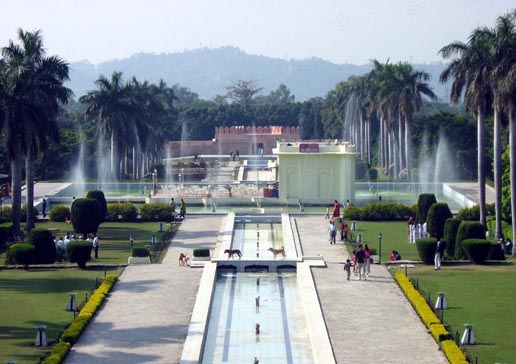
According to the landforms of the state Haryana is divided into four separate zones. These are the Yamuna Ghaggar plain, The Shivalik Hills area of the northeast zone, Semi-desert sandy plain of the southwest zone and The Aravalli Range of the southern zone. Read more...
Climate of Haryana
Climate of Haryana usually is arid to semi-arid type. It is extremely hot in summer and much cold weather in winter. The state is mainly influenced by three types of whether season, namely summer, winter and monsoon.
Weather in summer: Normally the summer season in Haryana is from the month of March to July. The temperatures vary during this season between 33°C to 47°C. But May and June are extremely hot, when the temperature may reach 43°C or above regularly. So, tourists avoid this season to rush at Haryana.
Weather in winter: Normally the winter season of Haryana is continued from End of November to Mid-February and the temperatures vary during this season between 2°C (except of Karnal and Ambala districts, avg - 14°C) to 10°C. January is the coldest month in Haryana, when the temperature may drop below the freezing point. It is the right time to planning a tour for Haryana.
Weather in monsoon: Normally the monsoon season of Haryana is continued from July to September. The state receives heavy rain during this season in the region of Shivalik Hill’s area. An average annual rainfall of the state is approximately 46 cm.
Culture of Haryana
Language and Religions in Haryana:Usually the people of the state use Hindi as their spoken and official language but some other dialects are also spoken like, Punjabi, Bangaru or Jatu (known as Haryanavi) and Urdu, in few areas. The people of Punjab mainly follow Hinduism (89.08%) rest are Sikhism (6.1%), Muslim (4.05%) and Christianity (0.10%).
Festivals in Haryana: The festival Lohri is one of the most important festivals in the state. It is celebrated during winter. Some other popular festivals of the state are Haryana day, Pinjore Heritage Festival Gangore, Baisakhi and Gugga Naumi. Most attractive annual fairs of Haryana are the Surajkund Craft fair and the Kartik Fair
Himachal Pradesh
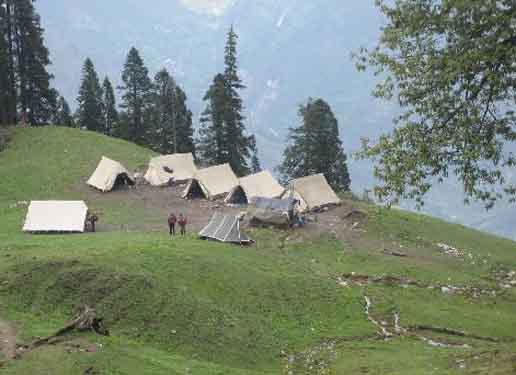
Culture of Himachal Pradesh
The people Himachal Pradesh have created a unique culture and tradition due to its complex and complicated land distribution throughout the whole state. Usually, the people of Himachal Pradesh speak in Hindi language but some other regional languages are also used as their local communication. Other regional languages are Pahari, Kinnauri, Mandialli Kangri, Gojri and Dogri. More than 95% of total people of Himachal Pradesh are follows Hindu religion. There is a custom of Hindu culture and tradition. The Local people celebrate their festival with local music and dance which reflects the unique cultural individuality of the state. They worship to their gods with their local dance and music.
Nati is a famous dance form 0f Himachal Pradesh. Usually the tribes of the state celebrate their festivals with this dance form. They celebrate several festivals in their own tradition and culture. The festival Dusseehra at Kulu district is a big celebration of the state. Besides of Dussehra a number of festival and fair are celebrate there. Mahashivratri in Mandi district (in the month of February or March), Minjar Festival in Chamba district, Lavi Fair at Rampur, Renuka Fair (in the month of Aught to September), Lohri or Maghi, Lahual and Phulech-festival is a festival of flowers.
Temples of Himachal
As the state is mainly covered with the people of Hindu religions, so, you will find lots of temple here. Among them the Lakshmi Davi Temple at Manimahesh, Paonta Sahib Gurudwara, Jwalamukhi Temple, Jakhu Hanuman Temple at Shimla the capital town, Bhimkali temple at Sarahan, Bajreshwari Devi temple at Kangra district are famous.
Jharkhand
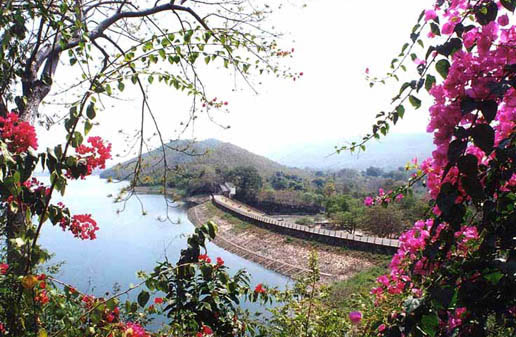
Climate of Jharkhand
| Note | |
|---|---|
| Area | 79,714 km2 (16th) |
| Capital | Ranchi |
| Largest City | Jamshedpur |
| Other Cities | Dhanbad, Bokaro, Deoghar, Phusro, Hazaribagh, Giridih, Ramgarh and Daltonganj |
| Location | East India |
| Population (2011) | 3,29,88,134 (13th) |
| Districts | 24 |
| Climate | Pleasant and equable throughout the year. |
| Best Season | February to April |
| Languages | HIndi (OL) and Urdu, Santhali, Bengali, Ho, Oriya, Mundari, Kurukh, Kurmali, Khortha, Kharia, Nagpuri |
| Currency | Indian Rupee( ) ) |
Climate of Jharkhand usually is tropical with hot summer and cold winter. The state is mainly influenced by three types whether season, namely summer, winter and monsoon. Some regions (Ranchi, Netarhat, and Parasnath) of the state are seeing a pleasant climate throughout the year even during the summer.
Weather in summer: Normally the summer season of Jharkhand is continued from End of April to Mid-June. The temperature varies during this season between 23°C to 38°C.
Weather in winter: Normally the winter season of Jharkhand is continued from mid of November to February and the temperatures vary during this season between 10°C to 20°C.
Weather in monsoon: Normally the monsoon season of Jharkhanda is continued from End-July to September. The state receives Several robust twisters during this season, which come in from the neighboring state West Bengal. An average annual rainfall of the state is approximately 47 cm.
Culture of Jharkhand
Languages in Jharkhand: Usually the people of the state use Hindi as their spoken and official language but some tribal or regional dialects are also spoken like, Santhali, Mundari, Ho, Kharia, Bhumij, Bengali, Maithili, Nagpuri, Sadri, Khortha, Kurmali, Panch pargania, Oraon, Korwa and Paharia in several areas.
People in Jharkhand: The native residents of Jharkhanda usually belongs to thirty-two distinct tribal community groups and the all of follows the Sarna religion, near about 12.8% of total resident belongs to this community. The main religion of the state is Hinduism near about 67.8% of total population follow this religion. Some other religion followers of the state are Sikhism (3.3%), Muslim (14.5%), Jainism (2.06%), Buddhism (1.02%) and Christianity (4.3%).
Festivals in Jharkhand: Holi is most popular festival in Jharkhand. Some other important religious festivals of the state are Divwali, Dashhara and Ramnavami, Chath and Baqra Eid. Several amusing big fair are also organized throughout the state like Kunda Mela (every year in February or March) at Pratappur, Kolhua mela in winter at Hunterganj, Kundri Mela at Chatra, Kolhaiya Mela in winter at Chatra, Tutilawa Mela at Simaria and Belgada Mela (in April) at Simaria.
The tribal communities of the state make their culture totally dissimilar to other urban communities and they practice a distinct culture which traditionally transfers to them. They celebrate several festivals like Bhagta Parab, Hal Punhya, Karam, Rohin, Sarhul and Tusu Parab.
Karnataka
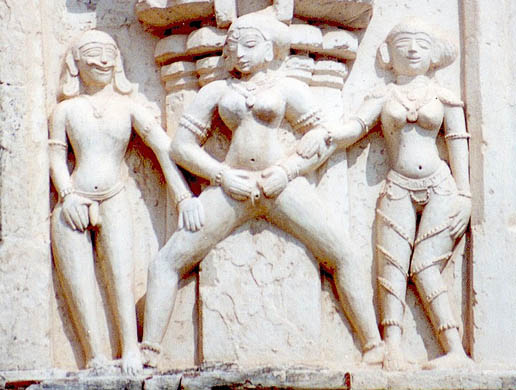
(A image one top of Matanga Hills of the Hampi historical site)
Climate of Karnataka
Karnataka is placed closer to the equatorial region of the World and so, the climate of the state is very comfortable due to its equable climate type throughout the year. But some high elevation regions of the state (especially in hill stations) receive some low temperature in winter.
Weather in summer: Normally the summer season of Karnataka is continued from mid of March to Mid-June. The average temperature in this season of the state is approximately 30° C.
Weather in winter: Normally the winter season of Karnataka is continued from end of November to February and the average temperature during this season is approximately 18° C.
Weather in monsoon: Normally the monsoon season of Karnataka is continued from mid of June to mid of September and the average rainfall during this season is approximately 150 cm.
Culture of Karnataka
Languages in Karnataka: Kannada is the main dialect of Karnataka and a majority percentage (64.8) of resident uses this as their first language as well as official language. Other used dialects of the state are Urdu (speak 9.6% of population), Hindi (speak 2% of population) Telegu (speak 1.14% of population), Marathi (speak 4% of population), Tulu (speak 3.3% of population) and Tamil (speak 3.9% of population). Some other community groups reside here with a less percentage spoken languages.
Festivals in Karnataka: Dussehra or Dasara is the most popular festival in Karnataka. It is celebrated throughout the state with huge interest. Some other major festivals of the state are the dance festival (in January) of Pattadakkal, Makar Sankranti, Karaga in Bangalore, Hoysala Mahotsava (in March), Ganesh Chaturthi, Festival of Hampi (in November) and Yugadi.
Religions in Karnataka: The people of Karnataka mainly follow Hindu religion (83%) rest are Muslim (11.1%), Christianity (3.9%), Jainism (0.07%), and Buddhism (0.8%). Some other religion groups reside here with a less percentage population.
Tour and Travel in Karnataka
The state Karnataka is the address of several ancient temples, superb hill stations, endless beaches and protected wildlife areas. More over 20.20 percent of total region of the state is covered with forest.
You will found lots of sanctuaries (twenty-five) and national parks (5 national parks) in Karnataka. Some major of these are Anshi, Tyavare koppa lion sanctuary, Bhagavati reserved forest, Banner ghatta national park, Dandeli Wildlife reserve, Bandipur national park, Nagara hole national park, Attiveri bird sanctuary, Ranebennor blackbuck sanctuary, Madhugiri black buck sanctuary, Ranganatittu Bird sanctuary, Mandagadde bird sanctuary, Bhadra reserved forest, Gudavi bird sanctuary, Kudremukh National Park and Daroji Sloth Bear Sanctuary.
Best beaches in the state are Murudeshwar, Karwar, Marwanthe, Bhatkal, Malpe, Ullal, Marvanthe, Gokarna and Om Beach. Some other beaches in Karnataka are Kurumgad, Surathkal, Mangalore, Panambur, Nitk, Akuna Matata, Kaup, Trasi, Jali, Nastar, Dhareshwara, Kumta, Paradise, Halfmoon and Kudle Beach.
The state is perfect destination to discover several super beauty waterfalls like, Abbey, Alekhan, Arisina gundi, Benne Hole, Burude, Chunchanakatte, Dondole, Gokak, Hebbe, Hogenakal, HonnemaraduIruppu, Jog, Kalhatta Giri, Kalhatti, Lalguli, Lalguli, Magod Falls, Nisargadhama, Sathodi, Shanti, Shivasamudram, Sirimane, Viboothi and Watta Halla water Falls
Major temple of the state are Mookambika, Belur Chennakesava, Virupaksha, Vittala temple, Chamundeswari, Belur Chennakesava, Sri Kukke Subramanya, Bagandeshwara, Bull Temple, Cave Temples, Channakeshava, Keshava Temple, Bahubali Temple, Manjunatha Swamy Temple, Annapoorneshwari Temple, Chaturmukha Basadi, Sringeri Mutt, Murudeshwar Mahadev, Savirakambada Basadi and Gokarnanatha temple.
Some other major attractions of the state are several hill stations, forts and ancient sculpture (temple of Hampi) of Hindu culture. Example of few major hill stations of the state are Nandi Hills, Kemmanagundi Hills, Madikeri Hills, Biligirirangana Hills, Kudremukh Hills, Coorg Hills, Kundadri Hills, Yana Hills, Chikmagalur Hills, Kodachadri Hills, Gangamoola Hills, Dakshina Kannada Hills and some attractive forts of the state are Belgaum, Bidar, Bijapur, Gulbarga, Jamalabad, Kavaledurga and Madhugiri fort.
Kerala
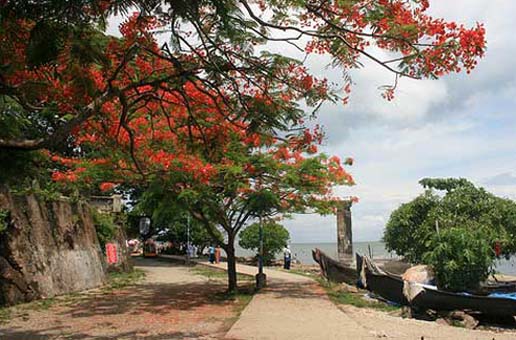
Climate of Kerala
Weather in summer: Normally the summer season of Kerala is continued from March to Mid-June and the temperature varies from 36°C to 30°C. During this season average 135 mm rainfalls receive this state.Kerala is placed closer to the equatorial region of the World and so, the climate of the state is very comfortable due to its equable climate type throughout the year. But some high elevation regions of the state (especially in hill stations) receive some low temperature in winter season and these high elevation regions produces heavy rain throughout the state.
Weather in winter: Normally the winter season of Kerala is continued from November to Mid of February and the temperatures vary from 28°° to 19°C. But some regions of higher elevation of hill stations the temperature often falls below 10°C.
Weather in monsoon: Normally the monsoon season of Kerala is two types - South West Monsoon and North East Monsoon.
South West Monsoon in Kerala: Southwest monsoon is continued from end of May or early June to September. During this season the state receive heavy rainfalls approximately 2250 mm to 2500 mm.
North East Monsoon in Kerala: This season is also known as the Retreating of southwest Monsoon winds. Usually it coincides with the month of October and November and sometimes lasts till December. During this season the state receive averaging rainfalls of 450 mm to 500 mm.
Culture of Kerala
Language and Religions In Kerala:People of Kerala usually use Malayalam dialect as their main spoken and official language, more than 96.56% of inhabitants speak this language and rest are use Tamil (2.11%), Tulu (0.38%), Kannada (0.26%), Konkani (0.22%), Telugu (0.16%) and rest are Hindi, Marathi, Gujrati etc. The people of Kerala mainly follow Hindu religion (56.2% of total population), Islam (24.7%), Christianity (19%) and rest 1.1% are local tribal or Adivasi.
Festivals in Kerala: Onam (August or September) is most popular festival in Kerala. Snake Boat race festival is also very popular in the state. Some other major festivals of Kerala are Thiruvathira Festival (in winter), Makaravillakku at Sabarimala, Bakrid, Christmas, Vishu, Thrissur Pooram, Ochirakali (during June), Ganesh Chaturthi, Kerala Foundation Day, Deepavali and Idul-Fitr.
Madhya Pradesh
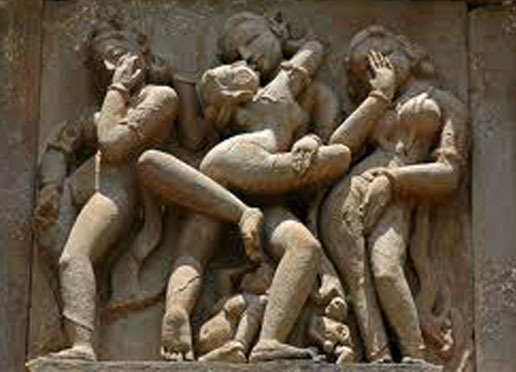
The capital city of Madhya Pradesh is Bhopal and the other major cities of the state are Indore, Jabalpur, Gwalior and Ujjain. The state is build up with ten divisions, namely Bhopal, Indore, Jabalpur, Gwalior, Ujjain, Rewa, Sagar, Chambal, Shahdol and Hoshangabad division. These divisions are contained with fifty distinct districts. Read more...
Climate of Madhya Pradesh
Climate of Madhya Pradesh usually is dry and subtropical type. The state is mainly influenced by three types whether season, namely summer, winter and monsoon.
Weather in summer: Normally the summer season of Madhya Pradesh is continued from End of March to June. The average temperature during this season varies between 36° C to 46° C.
Weather in winter: Normally the winter season of MP is continued from mid of November to February and the average temperature during this season varies between 10° C to 28° C.
Weather in monsoon: Normally the monsoon season of Madhya Pradesh is continued from July to September and the average rainfall during this season is approximately 175 cm.
Culture of Madhya Pradesh
Languages in Madhya Pradesh: Hindi is the main dialect of Madhya Pradesh and a majority percentage (more over 65%) of resident uses this as their first language as well as official language. Other major dialects of the state are Malvi in Malwa province, Nimadi in Nimar province, Bundeli in Bundelkhand province, and Bagheli in Bagelkhand and the southeast region. Some other languages are also used by the people of the state with less percentage. These are Telugu, Urdu, Bhilodi (Bhili), Gondi, Korku, Kalto and Nahali.
Religions in Madhya Pradesh: The people of Madhay Pradesh mainly follow Hindu religion (91.12%) rest are Muslim (6.38%), Jainism (0.9%), Christianity (0.3%), Buddhism (0.3%) and Sikhism (0.2%). Some tribal communities reside here with a percentage 20.28 of total population. Usually they follow Hindu religion. Major tribal of the state are Gond, Bhil, Baiga, Korku, Bhadia, Kaul, Mariya, and Sahariya. There have caste system in Hindu community like scheduled caste and scheduled tribes.
Festivals in Madhya Pradesh: The people of Madhya Pradesh celebrate lots of religious fair and festivals. Among these some most popular are Bhagoriya Festival, Dusshera at Bastar, Madai Fairs (February, March and April every year) located at Narayanpur, Kondagaon, Dantewara and Dhanara, Khajuraho Dances festival, Tansen Music Festival at Gwalior, Fair of Nagaji, Karam and Laru K
West Bengal
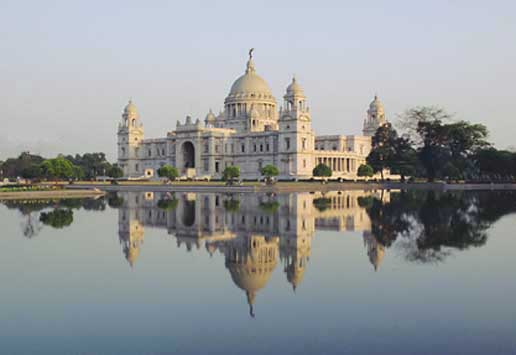
West Bengal is the only state in India which stretching from the great snow covered and majestic Himalayas in the North to the endless Bay of Bengal in South. West Bengal attracts people with its huge culture, heritage, and natural beauty. Where several forests like Sundarban, hills area like Darjeeling, sea beach like Digha, historical place like Gour, huge heritage city Kolkata (Calcutta) and festivals like Durga Puja are increased Bengal to famous all over the World.

No comments:
Post a Comment